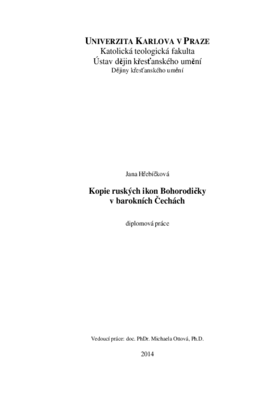Kopie ruských ikon Bohorodičky v barokních Čechách
The Copies of Russian Icons of Our Lady in Baroque Bohemia
diploma thesis (DEFENDED)

View/
Permanent link
http://hdl.handle.net/20.500.11956/53745Identifiers
Study Information System: 91145
Collections
- Kvalifikační práce [2255]
Author
Advisor
Referee
Royt, Jan
Faculty / Institute
Catholic Theological Faculty
Discipline
History of Christian Arts
Department
Institute of Christian Art History
Date of defense
20. 1. 2014
Publisher
Univerzita Karlova, Katolická teologická fakultaLanguage
Czech
Grade
Excellent
Diplomová práce "Kopie ruských ikon Bohorodičky v barokních Čechách" uvádí toto téma charakteristikou a nástinem počátků ikony. Ikona je v kontextu evropského umění velmi výjimečná a jedinečná tím, že není pouze obrazem zhotoveným specifickou technikou, ale zároveň představuje předmět kultu a samotnou "duchovní realitu". Toto pojetí ikony se definitivně kontituovalo po skončení ikonoklastických bouří roku 843. Z Byzantské říše přejímá po christianizaci umění ikony také Rusko. První ikony Bohorodičky v pravém slova smyslu začaly vznikat až po Efezském koncilu konaném roku 431, kdy nastal rozkvět jejího kultu i zobrazování. Při definování typologického rozlišování ikon Bohorodičky, které však není jednotné a obecně přijímané, se ustálilo několik základních ikonografických typů. V období baroka byly z různých evropských zemí do Čech importovány ikony Bohorodičky typu Hodégétria a typu Glykofilúsa. Jedná se o kopie zázračných ruských ikon Bohorodičky Hodégétrie Smolenské - Šujské, Bohorodičky Glykofilúsy Vladimirské a Bohorodičky Glykofilúsy Igorevské. Kopie ikony Bohorodičky Hodégétrie Smolenské představuje západní kopii této ruské ikony a není tedy pravděpodobně importem. Z těchto kopií ikon se dochovaly pouze tři ikony neznámé datace a provenience. Jsou jimi ikona Bohorodičky Smolenské - Šujské...
This thesis "The Copies of Russian Icons of Our Lady in Baroque Bohemia" at first presents characteristics of the icon and outlines its ancient beginning. The icon is unique in the context of European art, because it is not only an image made by a specific technique but, at the same time, a cult object and a "spiritual reality" by itself. This concept of icon was decisively established after the end of Byzantine iconoclasm period in the year 843. After the christianisation of Russia the art of the icon was spread there. The first icons of Our Lady did not appear until the Council of Ephesus (431), which marked expansion of the cult of Our Lady and her imagery. Within the typology of the icons of Our Lady were established several basic iconographic types but the typology itself is not unified and generally accepted. In the Baroque period there were icons of the Hodegetria and the Glykophilousa types imported to Bohemia from various European countries. They are copies of Russian miraculous icons of Our Lady of Shuya, Our Lady of Vladimir and Our Lady of Igor. Another copy, the one of Hodegetria of Smolensk is of western origin and presumably not an import. Out of these icons only three were preserved to this day. They are the Our Lady of Shuya icon in the depository in the town of Louny, Our Lady of...
